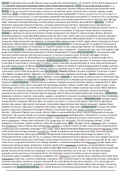Tentamen (uitwerkingen)
Cheatsheet Strategic Analysis - Module Strategic Hospitality Management
- Instelling
- NHL Stenden Hogeschool (NHL)
Example of a Cheatsheet which you can use within the Strategic Analysis exam of the module SHM. I used this cheatsheet and got an 8.2.
[Meer zien]













